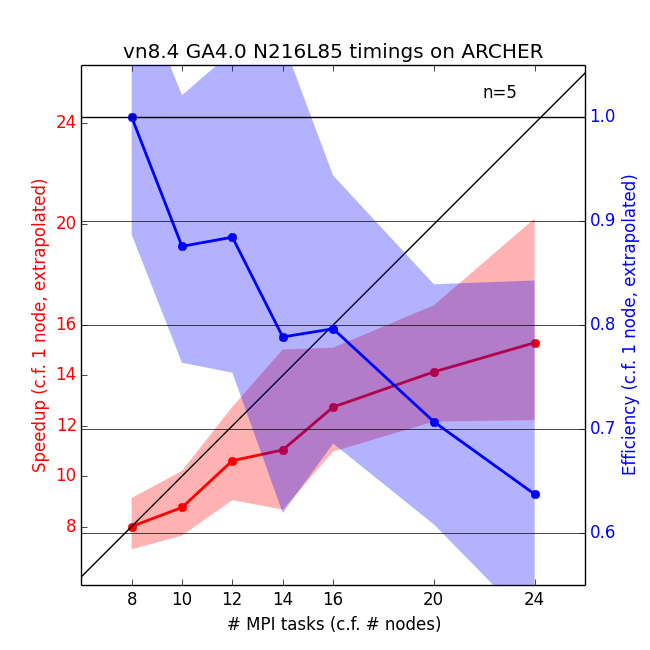Difference between revisions of "Supplementary Job SJ1.0"
| Line 4: | Line 4: | ||
It is a continuation of [[GA4.0 N216 Development]] - more information can be found on that [[GA4.0_N216_Development|page]]. |
It is a continuation of [[GA4.0 N216 Development]] - more information can be found on that [[GA4.0_N216_Development|page]]. |
||
| − | |||
===Base Model=== |
===Base Model=== |
||
| Line 29: | Line 28: | ||
<math>\rightarrow</math> <code>xfaym</code> owned by Malcolm Roberts<br> |
<math>\rightarrow</math> <code>xfaym</code> owned by Malcolm Roberts<br> |
||
<math>\rightarrow</math> <code>xhcea</code> owned by Jane Mulcahy<br> |
<math>\rightarrow</math> <code>xhcea</code> owned by Jane Mulcahy<br> |
||
| + | |||
| + | ===Scaling (ARCHER)=== |
||
| + | |||
| + | Each compute node contains two 2.7 GHz, 12-core Ivy Bridge processors, which can support 2 hardware threads, and there is 64GB of RAM per node. Due to memory restrictions, the N216L85 configuration is unable to run on less than 8 nodes (so the 8-node,20-minute <code>short</code> queue is available for debugging). All simulations used 2 OpenMP threads with 12 MPI tasks per node (halving the number of cores available per node). |
||
| + | |||
| + | Scaling tests have been done from 8 to 24 nodes of ARCHER with a series of 2-day runs, with the results presented below. |
||
| + | |||
| + | [[Image:ARCHER_timings_PPE_N216.png|400px]] |
||
==Contributions and Acknowledgements== |
==Contributions and Acknowledgements== |
||
Revision as of 09:26, 10 August 2015
This page documents the vn8.4 GA4.0 N216L85 supplementary job SJ1.0 (xjgvb/c on MONSooN and xjgve/? on ARCHER).
This job has been developed by Luke Abraham with help from several others.
It is a continuation of GA4.0 N216 Development - more information can be found on that page.
Base Model
The base atmosphere model used here is the GA4.0 configuration. More information on GA4.0 development can be found on Global Atmosphere 4.0/Global Land 4.0 documentation pages (password required). A GMD paper documenting this model is also available.
The configuration is based on the Met Office job anenj (via MONSooN job xhmaj) which is derived from amche (the standard GA4.0 N96L85 interactive dust model) via
vn8.4 N216 development
amche (base vn8.0 GA4.0 job) owned by Dan Copsey
xipvp (MONSooN) owned by Jeremy Walton
xjgva (made N216 by comparing aliur to ajthw) owned by Luke Abraham
xjgvb initialised from 1999-12-01 dump from xjgva, and made a TS2000 set-up
xjgve copied to ARCHER
reference vn8.0 jobs
- N96
aliur (base vn8.0 GA4.0 N96L85 job)
xipvo (MONSooN) owned by Jeremy Walton
- N216
ajthw (base vn8.0 GA4.0 N216L85 job)
xfthi (MONSooN) owned by Oliver Derbyshire
xfaym owned by Malcolm Roberts
xfaym owned by Malcolm Roberts
xhcea owned by Jane Mulcahy
Scaling (ARCHER)
Each compute node contains two 2.7 GHz, 12-core Ivy Bridge processors, which can support 2 hardware threads, and there is 64GB of RAM per node. Due to memory restrictions, the N216L85 configuration is unable to run on less than 8 nodes (so the 8-node,20-minute short queue is available for debugging). All simulations used 2 OpenMP threads with 12 MPI tasks per node (halving the number of cores available per node).
Scaling tests have been done from 8 to 24 nodes of ARCHER with a series of 2-day runs, with the results presented below.
Contributions and Acknowledgements
Luke Abraham would like to thank the following people (in no particular order) for their help in creating this job:
- Jeremy Walton (Met Office)
- Malcolm Roberts (Met Office)
- Jane Mulcahy (Met Office)
- Maria Russo (NCAS, University of Cambridge)
- Marie-Estelle Demory (NCAS, University of Reading)
- NCAS-CMS

